“The Best Version of Human Possibilities”: Barbara Kozłowska’s Planetary Conceptualism
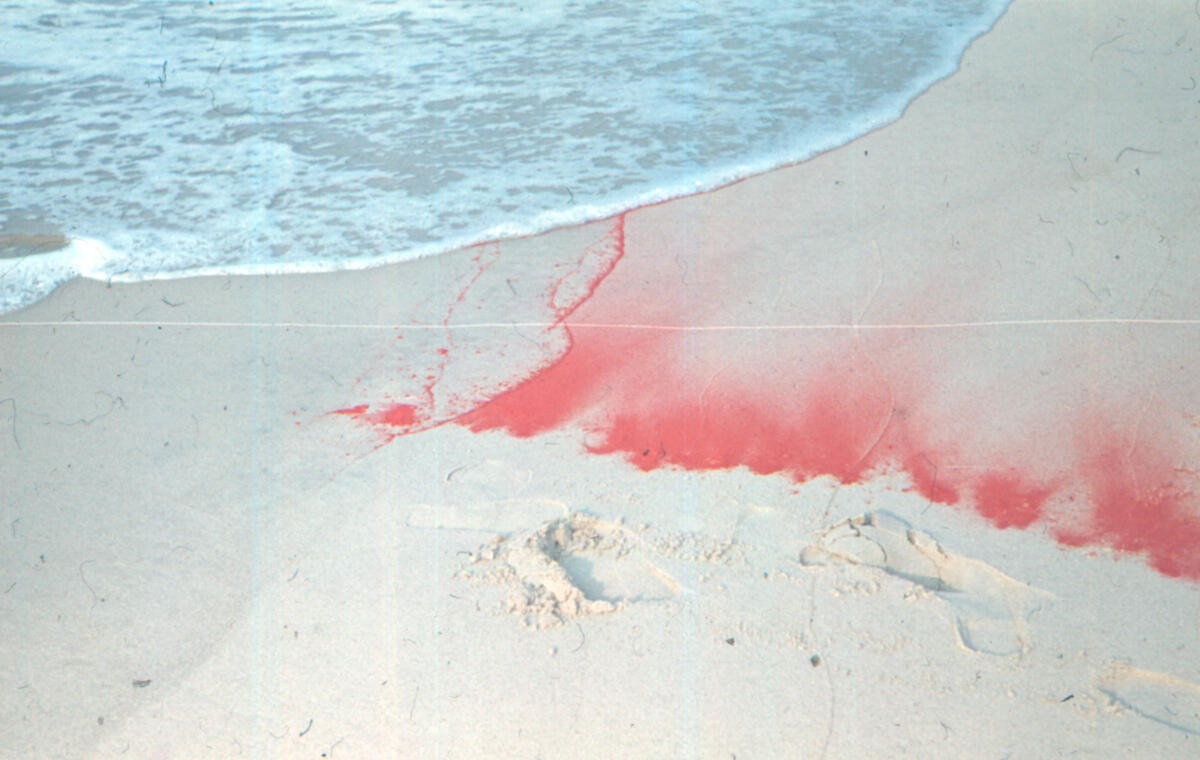
It is somewhat difficult at first to understand what can be seen in the photograph (fig. 1). A bird’s-eye view of a harmonious constellation of three multicolored matters. In the bottom-right corner, an oval patch resembling sea water meets the sand that fills the whole of the composition’s upper part. The sand perhaps bears traces of feet, which might offer a hint as to the scale of what we’re seeing. In the central part, a red cloud of pigment cuts diagonally across the rectangular composition. Another photograph (fig. 2) features a cone of blood-red pigment formed on sand, whose kneaded, wavy structure betrays human (non-)presence. But only when the view of a beach and the sea in a conventional postcard shot is added to these images (fig. 3) do we begin to understand that what we are facing is an artistic intervention in a natural landscape. Competing with the horizon line is a red, diagonal line of the pigment.
The series of photographs originates from 1970 and documents the action Marking the Borderline [Wyznaczanie linii granicznej] carried out by Barbara Kozłowska during the 8th Meeting of Artists and Art Theorists in Osieki, in collaboration with Antoni Dzieduszycki and Zbigniew Makarewicz. Some photographs depict the action in a wide shot, while others concentrate on details. It is the latter that resemble the lyrical compositions of matter painting, generated through juxtapositions of material fragments of nature. They are supplemented by a laconic bilingual description of the action, and a handwritten note with information concerning simultaneous observation of the borderline from five spots.
Zbigniew Makarewicz explained: “The idea was to indicate a line running across the entire globe, from the east to the west, so the concept was rather monumental, but, characteristically of Barbara, the work was also restrained as far as the means used are concerned. It merely consisted in marking one’s presence through photography or by forming sand cones on different beaches worldwide. Basia later colored those cones, using only colors from Newton’s scale, and then watched as the sea devoured them.”[1]
The artist embarked on her project in 1967 during – and, as it seems, as the result – of her first journey to Lake Baikal, where she borrowed the Siberian mountain form – a cone –from the local landscape. During subsequent years, Borderline [Linia graniczna], ephemeral and documented in photographic cycles or transposed onto videotape,[2] was marked by Kozłowska on beaches in Poland, Great Britain, Malta, and the USA. The actions followed a similar scenario, although “the idea depicted through an arbitrary decision adopted ever more varied germinal forms.”[3] Interestingly, photographic sequences from specific actions vary slightly in narrative, compositional, stylistic, and conceptual terms. This heterogeneity of the photographs indicates that they were not central to the artist’s focus. Their constant element remains the presence of the landscape, sea, beach, and sand cones, not always colored – as in the case of the project’s Maltese iteration. Kozłowska herself also appears in the photographs. In the one taken in San Francisco in 1990, the artist can be seen stretching her arms, thus co-shaping the horizon line (fig. 4). There is also a photograph from a kindred action in Świnoujście, titled Imaginable, taken facing the sun (fig. 5). Kozłowska looks into the camera, but her obscured face remains virtually invisible. It blends into her silhouette, which cuts a slant across the luminous background. Kozłowska points at the horizon. Her simple gesture holds extraordinary energy – physical focus, the concentration of matter, agency.
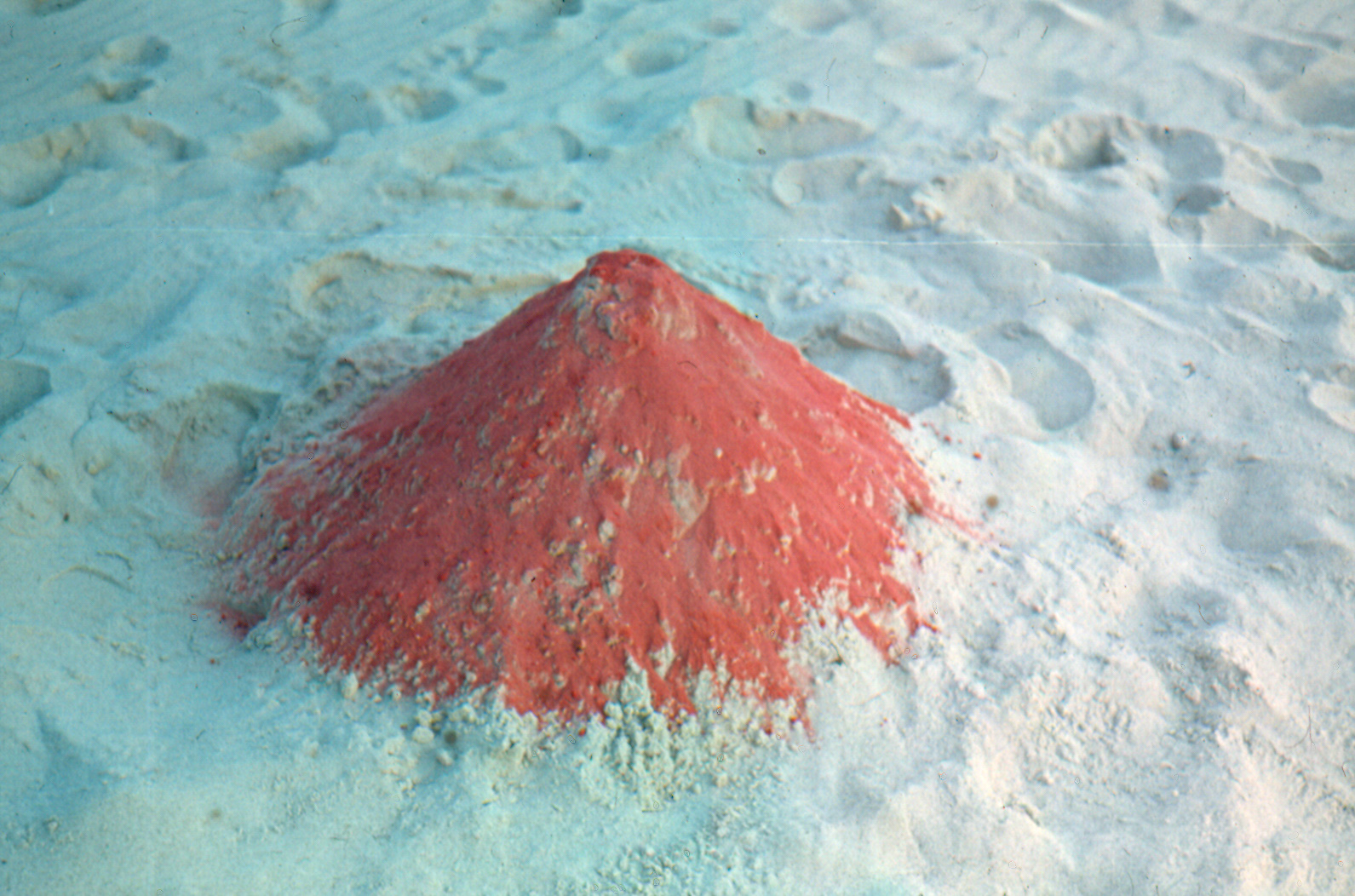
fig. 2. Barbara Kozłowska, ‘Marking the Borderline’ [Wyznaczanie linii granicznej], 1970, private archive
***
Kozłowska’s extremely varied, yet coherent and consistent artistic practice, which we discover by following her traces in her photographs and texts, invites many questions that result from it and were considered by the artist in her work, along with questions her work provokes from today’s perspective.
Kozłowska formed part of the Wrocław circle of concrete poets[4] and experimental conceptual artists. She put into practice her concept of art open to the viewer’s participation and activity, employing a broad range of artistic media and materials, such as action, activity, gesture, installation, text, textual-visual works, and – from 1972 – the institution of a conceptual gallery, existing in all places which offered “the possibility of a special encounter with people […] who wish to project their person expressed not through specific artworks, but rather through acts of establishing meeting spaces as certain artistic possibilities.”[5] The artist collaborated with founders and artists from the conceptual scene, and her close artistic friends included Zdzisław Jurkiewicz and Jerzy Rosołowicz, among others.[6] A major role in the development of her work was played by the cooperation with Zbigniew Makarewicz and the intellectual exchange with Jerzy Ludwiński.[7] Kozłowska participated in events recognized as seminal manifestations of Polish conceptualism, such as the Wrocław ’70 Symposium, the 8th Meeting of Artists and Art Theorists in Osieki in 1970, and the Dreamers’ Congress in Elbląg in 1971.[8]
Her professional artistic career began with training at the Architectural Painting Studio at the State Higher School of Visual Arts (PWSSP) in Wrocław (now the Eugeniusz Geppert Academy of Fine Arts in Wrocław), which was an artistic initiation in a syncretic field that combined the process of painting with thinking in spatial categories.[9] She also tapped into this type of co-existence or co-dependence of media and activities in her ephemeral works, with the use of pigments on/in the natural environment. Studies in architectural painting probably also involved confrontation with public art understood in the most archaic sense – not only as art that engages the viewer, but that also functions in physical (public) space, with it and through it. And it is in this sense that space was present in Kozłowska’s processual projects, as an intra-active, co-participating material.[10]
The initiatory action in space was the piece Continuous Falling [Ciągłe spadanie] (1968) at the Museum of Architecture in Wrocław. Alongside Zbigniew Makarewicz, Ernest Niemczyk, Wiesław Rembieliński, and Ryszard Zamorski, Kozłowska created an environment that became a spatial interpretation of Tadeusz Różewicz’s poem Falling. Inspiration drawn from literary texts remained a constant element of her work.
The genealogy of Kozłowska’s artistic practice can also be sought by tracing the motifs of the line, the point, and the marking of borders, which appeared therein. In this text, I would like to pose two questions as part of developing a historical perspective on her work – related to one another as they both originate from the Borderline. The first concerns the model of conceptualism practiced by Kozłowska; the second pertains to the planetary and environmental aspects of her practice, particularly in the context (or against the backdrop) of ecologically oriented art in Central and Eastern Europe during that era.
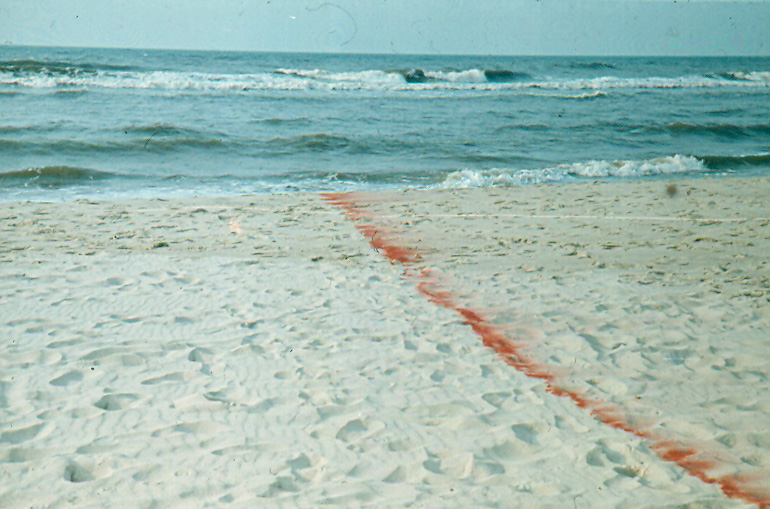
fig. 3. Barbara Kozłowska, ‘Marking the Borderline’ [Wyznaczanie linii granicznej], 1970, private archive
The idea of art is born out of reflection[11]: Barbara Kozłowska’s conceptual figurations
Do we still need the historical term “conceptualism” in order to understand art created at the turn of the 1970s, which challenged traditional media and sought new forms of production and distribution? On the one hand – in the discourse of global conceptualism – the term has become blurred. One of the ways to introduce a certain order in the field is to differentiate between conceptual art understood as a historical formation, and broadly understood conceptualism, embracing various artistic practices directly or loosely connected with the notion of process or action.[12] However, what contributed to the pluralization of the notion of conceptualism was not only the rush to lend paradigms a global dimension, but above all the feminist critique of defining conceptual art in a narrow, androcentric sense that pursued the reconstruction of the intentions of a narrow group of alpha-male activists.
The contemporary paradigm of decentring conceptualism through reconstruction of its manifold starting points follows the premise that plural modernisms also spawned conceptualisms. Globally applied conceptual aesthetics is therefore interpreted within diverse artistic biographies and local ideological and political contexts. What, then, are we dealing with when we say “conceptual art/conceptualism”? With a range of historical reconstructions and with the blurriness of the term itself.
The historicizing narratives devoted to the genealogy of conceptualism, such as the narrative of the administrative idiom of the late-capitalist society (Buchloh)[13]; focus on innovative distribution strategies (Alberro)[14]; the dematerialization of art (Lucy Lippard)[15]; ideologizations of art depicting the social realm (Mari Carmen Ramirez)[16]; the heterogeneity of Eastern European conceptualism and its political entanglements (László Beke)[17]; feminist critique of conceptual orthodoxy and logocentrism (Rosalyn Deutsche)[18]; as well as the latest material-semiotic analyses that focus on relations between matter and meaning (Christian Berger)[19] – as historical reconstructions – relate to specific sets of practices and cannot be easily extended to embrace other projects in alternative locations.
Luiza Nader’s proposal to approach historical conceptualism as a discursive formation – an antagonism, whose essence consisted in the heterogeneity of definitions – remains topical.[20] In the Polish context, this dispute involved both Ludwiński’s concept, according to which conceptualism was defined as a space between art and linguistic logic, excluding many artists of the era from the field of conceptual art, and also a range of individual artistic stances and propositions of conceptual art, embracing conceptualism founded on tautology, language, intermedia, or activity.
Given the lack of clarity of the very term “conceptualism,” what might an attempt to reconstruct Barbara Kozłowska’s model of “conceptual art” involve? My primary goal is to connect her unique mode of art-making with a particular historical context, while participating at the same time in the further pluralization of (the canon of) Polish conceptualism. Another aim is to tap into knowledge concerning that embodied practice, in order to open up a new perspective on the possibilities of defining historical conceptualism.
Just as Barbara Kozłowska searched for a new syncretic language of art within the idiom of conceptual art, her art today compels a more flexible approach to descriptive language. That is why I propose to approach “conceptual art/conceptualism” in this text from a perspective inspired by post-metaphysical feminist epistemology, which employs the notion of figuration. Figurations, as defined by Donna J. Haraway, are “performative images that can be inhabited”[21] – embodied notions that “do not stand outside the world they describe, but are living maps and transformative accounts never detached from their geopolitical and historical locations.”[22] This theoretical framework not only offers the possibility of embracing the dialectical relation between a specific artistic practice and the conceptual formation, but also to grasp “conceptualism” as a figuration of becoming. On the one hand, in this perspective conceptualism is a map that organizes Kozłowska’s imagination – a map with no precise borders, but with suggestive characteristics. On the other hand, it is a map that requires constant reproduction and rewriting; it is created by the user, and since it constantly transforms, it influences her practice and modifies it. Yet, most interestingly, motifs and figures used by the artist can be understood in this context as conceptual figurations.
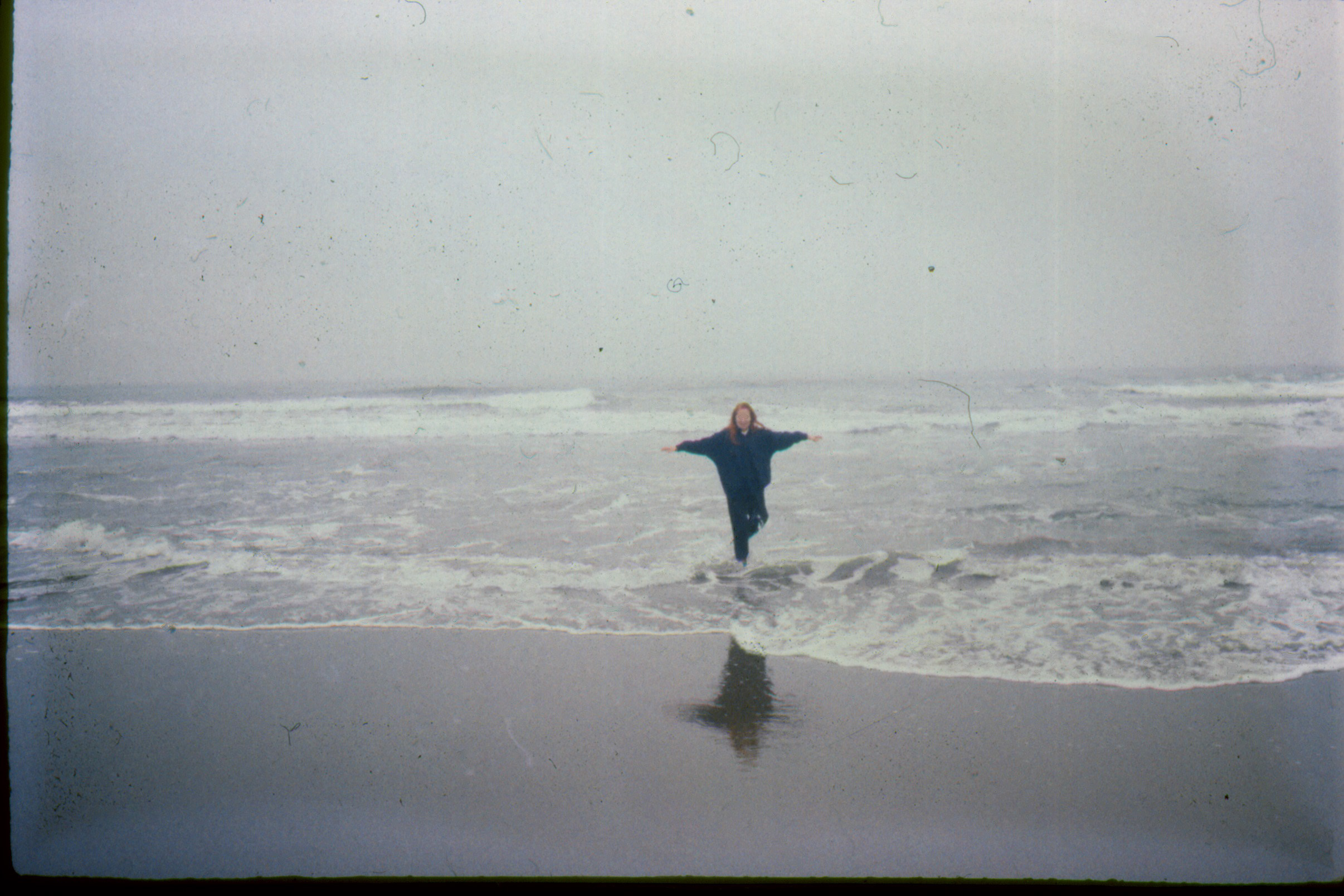
fig. 4. Barbara Kozłowska, ‘Borderline’ [Linia graniczna], San Francisco, 1990, private archive
Notions used by Kozłowska, such as field, area, line, point, and perception, formed part of the repertoire of figures evoked by the adherents of conceptual art, but were mostly perceived in the conceptual, mental sphere. In the case of Borderline, its physical, material dimension was equally significant.
In Zbigniew Makarewicz’s text from 1977 devoted to the analysis and genealogy of Borderline, tracing its origins to the area in between – Kozłowska’s experiments in the field of expanded painting and spatio-temporal sculpture – the author wrote about the material aspect of the line: “The lines of rivers, roads, flight. The line of a journey traced by man as a point that moves in space across the borders of states and continents, and above borders.”[23] Małgorzata Dawidek Gryglicka adds: “The very notion of the line appears in her work as a determination of the line of the shore, river, road, flight. It reflects the diagram of a journey, the trace of a track running from one point coded by history to another; it is a drawing in space […].”[24]
The line therefore did not “merely” function as documentation, akin to objects in conceptualism, but went beyond this rank. Using Donna J. Haraway’s suggestive vocabulary, we might say that Borderline belonged to the order of metaphorical realism, and marking it was a material-semiotic process. In other words, in this work-in-process, the idea and the material form do not diverge as they do in similar conceptual-linguistic projects, but are rather co-constitutive and co-existent. Borderline is embodied – situated spatially, territorially, connected with the environment. As a physical object, it evokes the categories of impermanence and dependence on uncontrolled natural processes, its material transformations observable at such critical points as where the sea and land meet, but also on the processes of life and death, the line of the artist’s life – as a work that “needs to constantly develop in order to live as long as the artist lives.”[25] As a mental object, it is always a fragment of the infinite, a potentiality.
A different kind of conceptual figuration that appears in the artist’s work – an object that exists simultaneously in the literal and symbolic senses – is the fractal. Akin to the line, the fractal is a mathematical notion, a specific and complex structural model. Fractals occur in nature – they materialize in physical phenomena as diverse as snowflakes, the circulatory system, river water systems, lightning, and cauliflower florets. A fractal appears in Kozłowska’s drawing from 1972 (fig. 6) as a model of the concept of the Borderline project. In a much later text from 2005, the artist defines fractals as “a structure that constructs our reality – trees, stones, waves.”[26]
The fractal is therefore a certain model of the universe, embodied or materialized in smaller individual phenomena. Kozłowska searched for such a model from the beginning of her artistic activity. In 1973, she wrote: “I agree with the claim that the artist is a discoverer.”[27] Her explorations often adopted the form of reflection on the dualism of reality.
In the action Arrhythmia [Arytmia, 1980], an anatomical model is confronted with its individual embodiment – the artist’s own body. The determination of relations between the particular, the embodied (arrhythmia), and the universal (rhythm) is also reflected in the form of visual poems, in which Kozłowska contrasted handwriting, originating from an individual body, with neutral typescript (Snow, 1976), or in the form of an abstract mathematical model of relations between the point (oneness) and the line (multiplicity), which provided the conceptual model for Borderline.
The interest in thus-understood dualism (idea/embodiment) also informs work devoted to the laws of perception. In the performance Point of View [Punkt widzenia, 1978] Kozłowska considered a number of classic anthropocentric models of reality perception, setting her own, individual body in motion (which, according to the artist, “expresses an element of life”),[28] using it as a tool to verify the workings of abstract concepts.
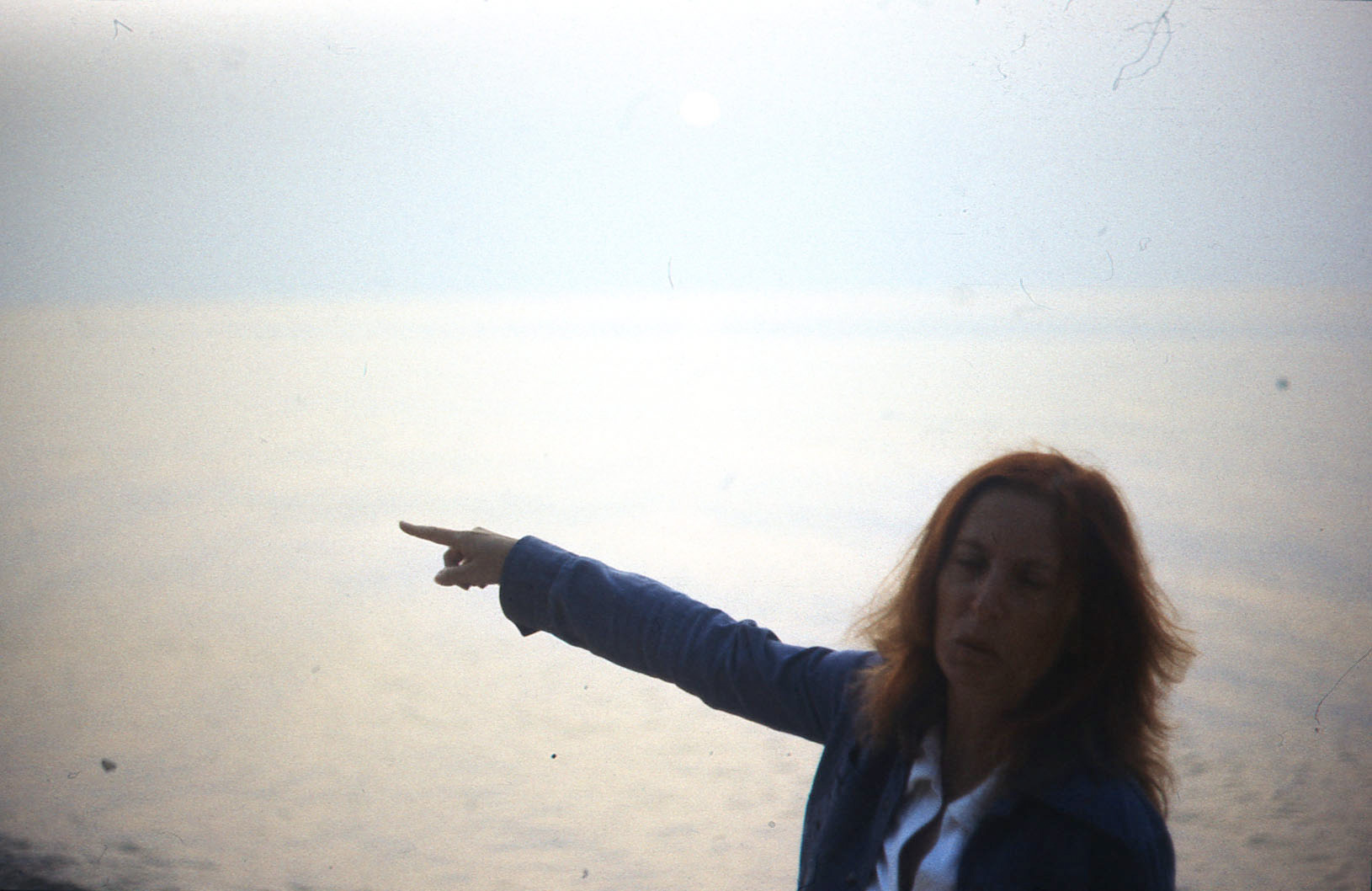
fig. 5. Barbara Kozłowska in Świnoujście, Poland, 1990, private archive
Moreover, that work once again articulated the idea that accompanied the artist and which she put into practice: “Everything that can be anywhere.” This was not a category of existence specific to Kozłowska’s work; many other conceptualists who created projects in open space referred to the non-arbitrariness of the beginning of their activities, imprints, markings, and appropriations of space. A good example is Zbigniew Gostomski’s piece It Begins in Wrocław [Zaczyna się we Wrocławiu], described by Luiza Nader as one of the few projects related to conceptualism created during the Wrocław ’70 Symposium which followed the principle that “ideas, concepts are both the starting point and the destination point of the artistic fact.”[29] According to the concept of a three-dimensional system of elements marked on the city map, marking “could start anywhere.” Another example is Jarosław Kozłowski’s project Expedition [Ekspedycja], “which may begin at any moment.”
While the two abovementioned conceptual works belonged to the sphere of impossible projects, the conceptual figuration of Kozłowska’s Borderline constituted both a mathematical, abstract, impossible model and the material aspect of anywhere, understood as “at any moment, in any place.” The line was marked, was material, but at the same time “impossible” in itself as something infinite, all-embracing. On the other hand, it was immanent and necessary; the artist did not so much create it, but rather revealed it. In a text published in 1973, Kozłowska defines “an important work” as something that must come into being, as a certain necessity. The artist writes that “an important work will appear in the artist’s proper idea anyway.”[30]
The material aspect of Borderline unfolded in a real space; it was related to the use of materials existing in nature. In the abovementioned text, Kozłowska reveals the relations between her works and extra-artistic reality, writing about found material as the foundation of her activities:
The search for new artistic areas entails the necessity of discovering in oneself the ability to decide to shape non-artistic novelties in art into an artistic form. It should be assumed, of course, that a found material is both clay, paint, and a mathematical model or the fact of traveling, and therefore time, and movement, and mass, and thought, and vision, and sensation. In my understanding, a found material is a source matter for artistic shaping because it is as yet undiscovered in art. So a source of interest to us would be every source that exists and is uncontaminated by artistic functions, and thus releases creative energy.[31]
Therefore, the artist did not consider space as a found material, but rather an effect of perception. An interest in the category of space in many aspects, always in relation to the possibility of perceiving it, is present, among other examples, in the early work on paper Spherical Surface in Motion [Powierzchnia kulista w ruchu, fig. 7] from 1969, in which the human being is defined in visual terms and in the accompanying text as the center of the configuration and the “producer” of space. The piece City-Cosmos [Miasto-Kosmos], created for the Wrocław ’70 Symposium, was accompanied by the text Space as an Information Configuration [Przestrzeń jako układ informacyjny]. The work, which consisted of “infinite transformations of an assumed configuration of points projected each time on a different map, complete with the proposal of implementation in growing dimensions of space,”[32] is indicated by Zbigniew Makarewicz as the source of the later Borderline. According to Makarewicz, it is its conceptual seed.[33]
By marking the Borderline, Kozłowska constituted space, setting relations and programming interactions with it. She created something of a continuum, with the focal point located in her own living body. The understanding of the processual meaning of space in the artist’s work is facilitated by Doreen Massey’s texts. She emphasizes that, although our basic assumptions and the categories in which we think about space merit attention, it is worth taking up the challenge of considering space in a different, more abstract way. The author proposes the recognition of space as a product of mutual relations constituted by interactions: as a field where diversity exists in the sense of a simultaneous multiplicity, and as a domain where separate trajectories co-exist – a sphere that combines heterogeneity.[34] Massey states that space is a product of relations that are embodied material practices, which always exist in process.[35] In this sense, by marking the Borderline, Kozłowska determined the geography of relations: by establishing relations between entities and materials, she created space herself.
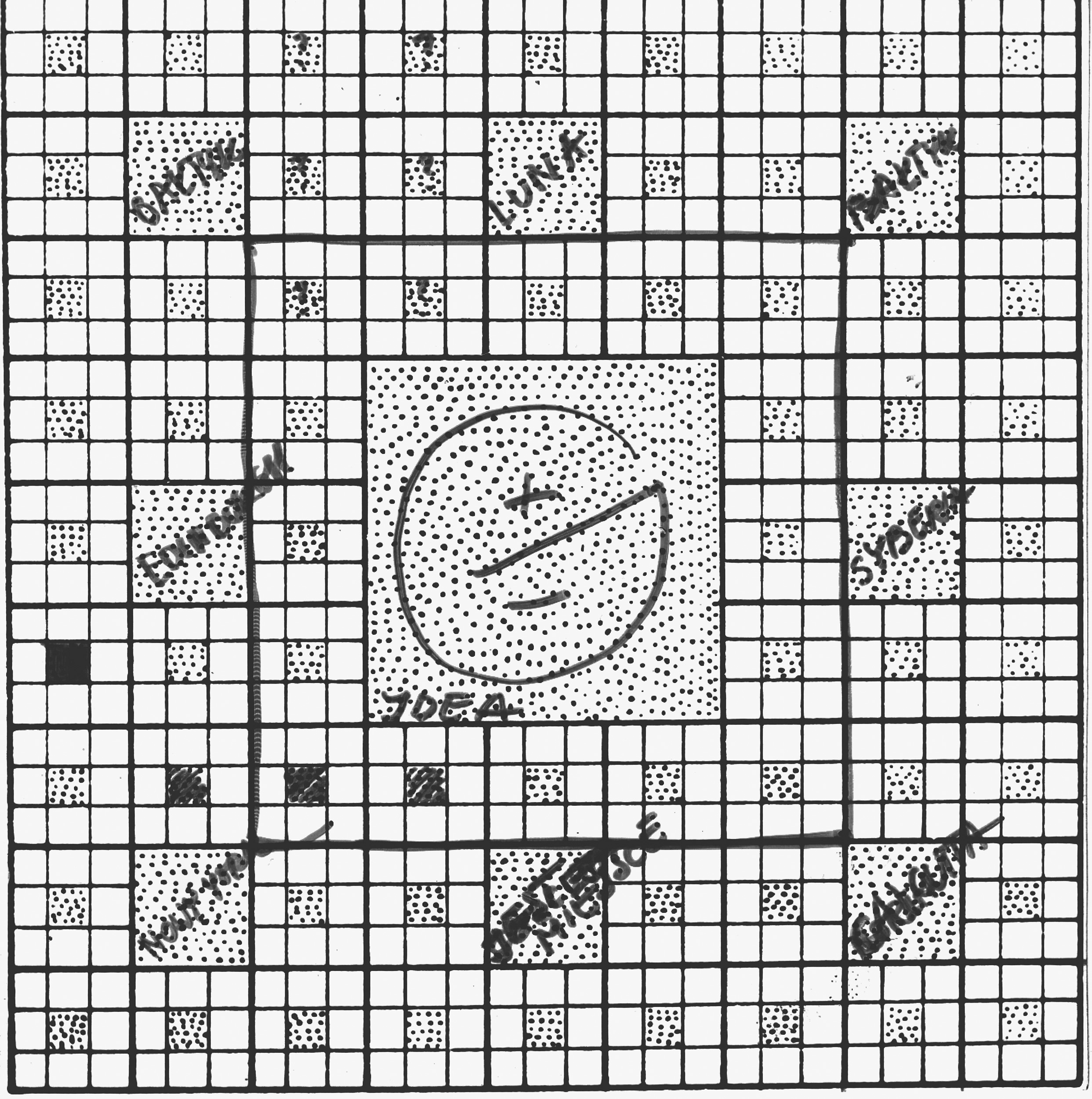
fig. 6. Barbara Kozłowska, ‘Schemat Linii granicznej w formie fraktalu’, 1972
In her text/manifesto For Space, Massey combines spatial and political imagination. She writes that thinking about space can change the way in which certain political questions are formulated, and that “the very possibility of any serious recognition of multiplicity and heterogeneity itself depends on a recognition of spatiality.”[36] Seen in this context, the practice of indicating the Borderline on the surface of the planet is tantamount to radical openness to the future, to unknown history.[37] In Borderline, the world is not a world of East and West, a world of political blocs and nation states – it is a planet, a diverse Gaia. Similarly to Massey’s analyses, Kozłowska in her work brings space to life – she indicates it as a place of potentialities, relations, and continuations. In Massey’s conception, it is an open space of torn-off ends and missing links, a dimension of things that exist next to each other, which confronts us with the fact of the existence of other (human and non-human) entities. “Perhaps the most crucial aspect of the dimension we call ‘space’” – writes Massey – “is that it is the dimension of multiplicity, of the more-than-one. One vital thing that that insight gives us is the insistence, even within globalisation, on a plurality of positionalities.”[38]
Relational thinking about space therefore brings us closer to the social dimension of indicating the Borderline. In the previously mentioned text from 1977, Zbigniew Makarewicz wrote: “Just as it always happens, also now the essence of activity is revealed to the author in the course of creating the work. The difference is that this revealing happens in front of our very eyes, and the way in which the entire community exists is undoubtedly included in this process.”[39]
But the sea and the sun were there before[40]: Ecological aspects of Barbara Kozłowska’s work
In her text from 1999, Kozłowska describes Borderline in retrospect, drawing attention not only to the processual character of the project and the immanent fragmentariness of its record, but also referring to the conditions of the (co-)existence of that “activity on the sea”[41] with the natural environment: “The idea of Borderline – a colorist beach – complies with the laws of ecology. What matters is the use of pigments, paper – non-toxic materials.”[42] However, traces of the artist’s ecological awareness can already be found in her text from 1973. Kozłowska underlines that the use of found materials in her work not only serves the goal of artistic progress, but also a (rather imprecisely defined) renewal, which can be interpreted from today’s perspective in the context of the social mission of ecological art (“the sources would be informed by a twofold goal – artistic and that of renewal”).[43]
Borderline is therefore also a proposal of what a paradigmatic change might look like in thinking about relations between humans and nature. The piece likewise hints at the necessity of changing the scale of perception and activity. The modern-day ecological crisis compels reflection pursued on a different, greater scale – planetary, geological, prehistorical. Gayatri Chakravorty Spivak made an important differentiation between the global and the planetary perspective, arguing that if the notion of globality is a virtual abstraction, which allows us to “think that we can aim to control globality,” the planet “belongs to another system,” in which we live following the principle of borrowing from it. That is why thinking in planetary categories, i.e. thinking about ourselves as “planetary creatures,” does not entail an unambiguous hierarchization, and allows us to position ourselves not as those who subordinate, but those who are co-dependent.[44]
Barbara Kozłowska undoubtedly took an interest in the co-dependencies and regularities occurring between human beings and the cosmos, as well as in the natural world: the cyclicality of the structure of the universe, changeability and permanence, with endlessness and measurement as its phenomena. She posed questions about the model of the world’s structure on the borders between light and darkness, lasting and disappearing, sea and land. However, Kozłowska’s planetary works are not devoid of individual experience – just as the piece Negatives of Fiction [Negatywy fikcji], which relies on the phenomenon of light and darkness, features the indication of a specific date, in Borderline it is the artist’s presence in a given place, at a given time, that enables indication of the line.
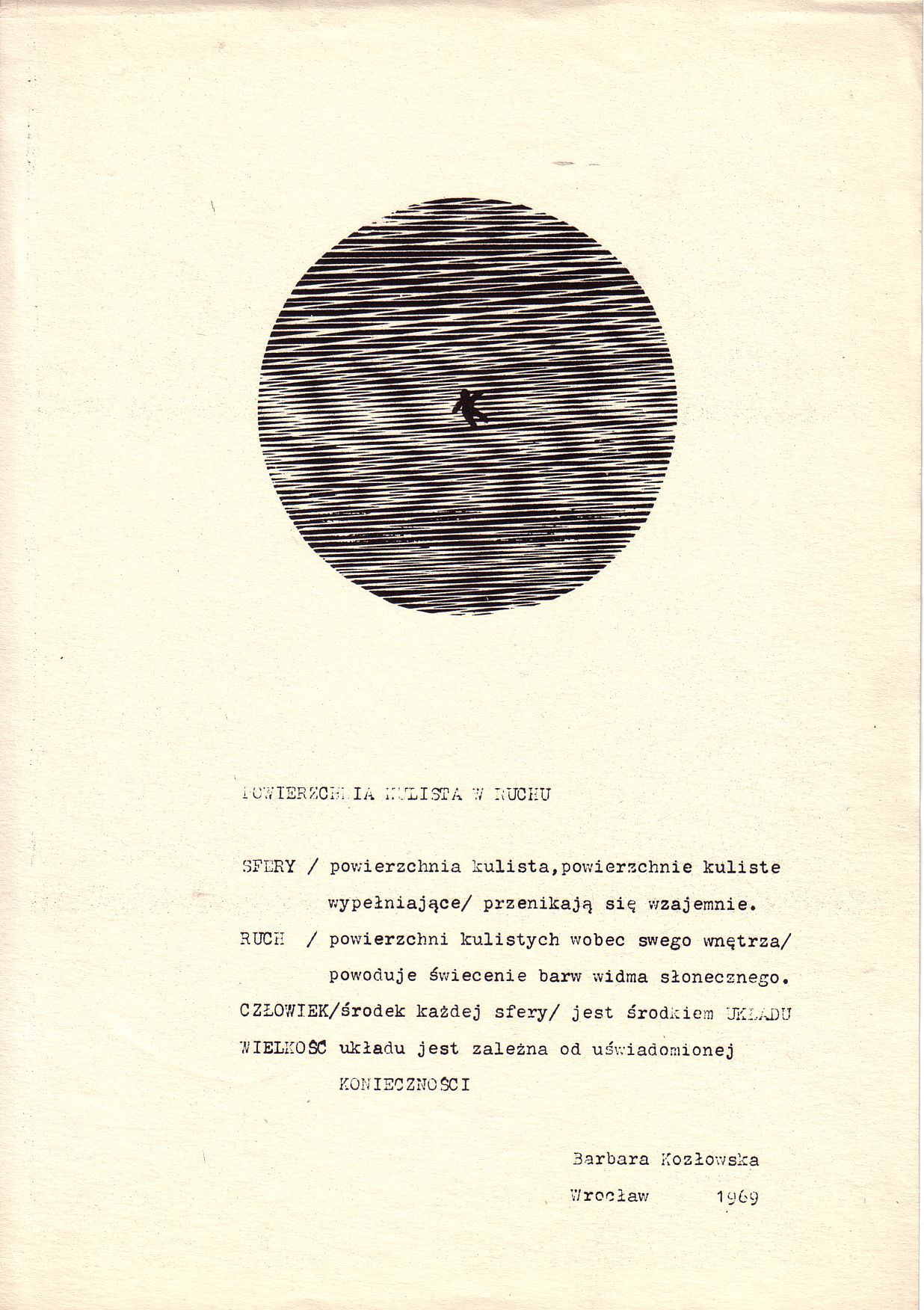
fig. 7. Barbara Kozłowska, ‘Spherical Surface in Motion’ [Powierzchnia kulista w ruchu], 1970, print from the exhibition ‘Sztuka Pojęciowa’, private archive
In Negatives of Fiction, created for the first time in 1978, Kozłowska relies on the motif of black and white in order to indicate a certain regularity and impose her individual trajectory on this impersonal rhythm. The motif also appears in her projects that refer to literary texts, such as Babel (Borges) from 1979, and becomes the dominant theme of her practice in visual poetry (Snow from 1976; variations on the Greek letter tau).
According to Maja and Reuben Fowkes: “The planetary aspects of East European art can be uncovered in a host of artistic, curatorial, and art historical positions toward the ecological crisis of late socialism, although these did not constitute a coherent movement and were rich in contradictions and dissonances.”[45] Kozłowska’s art sits comfortably in the traditions of Central European avant-gardes, such as the OHO Group, characterized by increased ecological awareness and considered, respectful use of the natural environment. Central and Eastern European neo-avant-garde artists who worked with the environment not so much intervened in the natural space, but rather situated abstract elements in natural contexts in order to observe processes of integration and decomposition. An interesting example is offered by the activity of Czech artists working primarily with water, such as Karel Miler (Uncovering the River, 1975), and Milan Maur, for whom – as Pavlína Morganová writes – “Water also became […] a constant source of various records, including tracing the hanging shape of the riverbank, the water level, and recording melting ice.”[46] Such activities were characterized by intimate, restrained, non-invasive, tiny gestures performed in relation to nature and within it – abstract visual signs reduced to the minimum, which investigated the so-called fundamental laws of nature: the separation between night and day, land and sea.
Akin to the abovementioned artists, instead of intervening in nature, Kozłowska practiced indicating and all its synonyms: constituting, determining, designating, circumscribing, marking, outlining, defining, pointing, specifying, pinpointing, concretizing, formulating, sketching, delineating, singling out, assigning. Her Borderline does not separate, but – owing to the artist’s presence – connects phenomena and points in space filled with the active matter of nature. In 2005, the artist wrote: “Nature is where void appears. Nature is not controlled by the creative human being because it is creative itself, and it is the human being who draws inspiration from nature throughout the centuries. It is an endearing act of creating out of nothing something that brings us to the peak of humanity.”[47]
[1] “Znana i nieznana. Rozmowa o Barbarze Kozłowskiej.” Zbigniew Makarewicz in conversation with Marika Kuźmicz, Magazyn Szum, July 31, 2016, https://magazynszum.pl/znana-i-nieznana-rozmowa-o-barbarze-kozlowskiej/ (accessed March 5, 2020).
[2] Makarewicz uses this term with reference to the iteration of Borderline in Malta in June 1975. Cf. Zbigniew Makarewicz, “Linia życia i linia sztuki Barbary Kozłowskiej,” Nadodrze no. 12 (388), June 12–25, 1977.
[3] Ibid.
[4] On the specificity of Barbara Kozłowska’s work and, more broadly, on the Polish specificity of the concretist movement, see: Małgorzata Dawidek Gryglicka, Historia tekstu wizualnego. Polska po 1967 roku (Krakow: Ha!art, CMW, 2012), especially the chapter “Topografia linii według Barbary Kozłowskiej,” 304–322.
[5] Barbara Kozłowska, “Języki” (undated typescript), http://repozytorium.fundacjaarton.pl/index.php?action=view/object&objid=4318&colid=90&catid=26&lang=pl (accessed April 5, 2020).
[6] Zbigniew Makarewicz talks about this in “Znana i nieznana…”
[7] Testament to the longevity of these inspirations is, among others, the fact that in the project Model from 1999, concerning the establishment of the Museum of Modern Art in Wrocław, Kozłowska refers to Jerzy Ludwiński’s initiatives, such as the Museum of Current Art and the Center for Artistic Research. She also proposes here a decentralization and spatialization of the institution – the museum is devised as a process, an activity across the entire Lower Silesian Region. See: Barbara Kozłowska, “Modele” (1999), http://repozytorium.fundacjaarton.pl/index.php?action=view/object&objid=4319&colid=90&catid=26&lang=pl (accessed April 3, 2020).
[8] The arbitrariness of this perspective is discussed by Luiza Nader, who argues that conceptualism was in fact relegated to the margins of these events. See: idem, Konceptualizm w PRL [Conceptualism in the Polish People’s Republic] (Warsaw: Foksal Gallery Foundation, University of Warsaw Press, 2009), 340–396.
[9] Kozłowska defended her diploma dissertation, titled Architectural Painting for the Designed Pantomime Theater in Wrocław in Ceramic Technique: Design and Execution of a Fragment of Polychromed Ceramic Relief [Malarstwo architektoniczne w technice ceramicznej do projektowania gmachu Teatru Pantomimy we Wrocławiu. Projekt i wykonanie fragmentu polichromowanego reliefu ceramicznego], in 1965.
[10] The term “intra-active” was proposed by the feminist theoretician of science Karen Barad in Meeting the Universe Halfway: Quantum Physics and the Entanglement of Matter and Meaning (Durham & London: Duke University Press 2007), in which she presents a new materialist theory of agential realism.
[11] Barbara Kozłowska, “Konceptualizm polski” (June 1999), http://repozytorium.fundacjaarton.pl/index.php?action=view/object&objid=4322&colid=90&catid=26&lang=pl (accessed April 5, 2020).
[12] See e.g. Terry Smith’s text, in which the author writes: “It is important to delineate a clear distinction between conceptual art as a term used to denote an essentially formalist practice developed in the wake of minimalism, and conceptualism, which broke decisively from the historical dependence of art upon physical form and its visual appreciation. Conceptualism was a broader attitudinal expression that summarized a wide array of works and practices which, in radically reducing the role of the art object, reimagined the possibilities of art vis-à-vis the social, political and economic realities within which it was being made. Its informality and affinity for collectivity made conceptualism attractive to those artists who yearned for a more direct engagement with the public during those intense, transformative periods. For them, the de-emphasis—or the dematerialization—of the object allowed the artistic energies to move from the object to the conduct of art.” Terry Smith, “One and Three Ideas: Conceptualism Before, During, and After Conceptual Art,” e-flux Journal, January 29, 2017, https://www.e-flux.com/journal/29/68078/one-and-three-ideas-conceptualism-before-during-and-after-conceptual-art/ (accessed February 6, 2020).
[13] Benjamin H. D. Buchloh, “Conceptual Art 1962–1969: From the Aesthetic of Administration to the Critique of Institutions,” October vol. 55 (Winter 1990), 105–143.
[14] Seth Siegelaub and Alexander Alberro, Conceptual Art and the Politics of Publicity (Cambridge, MA: The MIT Press, 2003).
[15] Lucy R. Lippard, Six Years: The Dematerialization of the Art Object from 1966 to 1972 (New York: Praeger, 1973).
[16] Mari Carmen Ramirez, “Blueprint Circuits: Conceptual Art and Politics in Latin America,” in: Latin American Artists of the Twentieth Century, ed. Aldo Rasmussem, exh. cat., The Museum of Modern Art, New York, June 6 – September 6, 1993, 156–166.
[17] László Beke, “The Present Time of Conceptual Art. The Political Implications of Eastern European Art,” http://www.vividradicalmemory.org/htm/workshop/bcn_Essays/Present_Beke_eng.pdf (accessed March 20, 2017). The text refers to the presentation Radical Conceptual Art Revisited, held at the Barcelona Workshop in May 2007.
[18] Rosalyn Deutsche, “Inadequacy…,” in: Silvia Kolbowski, Inadequate… Like… Power, ed. Frank Rilke, exh. cat., Secession, Vienna, September 17 – November 11, 2004, 67–70.
[19] Conceptualism and Materiality: Matters of Art and Politics, ed. Christian Berger (Boston: Brill, 2019).
[20] Nader, Konceptualizm w PRL, 12.
[21] Donna J. Haraway, Modest_Witness@Second_Millennium.FemaleMan_Meets_OncoMouse: Feminism and Technoscience (New York–London: Routledge, 1997), 11.
[22] Federica Timeto, “Diffracting the Rays of Technoscience: A Situated Critique of Representation,” Poiesis Praxis no. 8 (2011), 151–167, https://www.ncbi.nlm.nih.gov/pmc/articles/PMC3234354/ (accessed March 3, 2020).
[23] Makarewicz, “Linia życia i linia sztuki.”
[24] Dawidek Gryglicka, Historia tekstu wizualnego, 304.
[25] Makarewicz, “Linia życia i linia sztuki.”
[26] Barbara Kozłowska, “Fraktale” (Wrocław, 2005), http://repozytorium.fundacjaarton.pl/index.php?action=view/object&objid=4316&colid=90&catid=26&lang=pl (accessed April 2, 2020).
[27] Barbara Kozłowska, “Fraktale” (Wrocław, 1973), http://repozytorium.fundacjaarton.pl/index.php?action=view/object&objid=4316&colid=90&catid=26&lang=pl (accessed April 5, 2020).
[28] Barbara Kozłowska, “Punkt widzenia” (Wrocław, 1978), http://repozytorium.fundacjaarton.pl/index.php?action=view/object&objid=3662&colid=84&catid=26&lang=pl (accessed April 6, 2020).
[29] Nader, Konceptualizm w PRL, 355.
[30] Kozłowska, “Fraktale” (2005).
[31] Ibid.
[32] Makarewicz, “Linia życia i linia sztuki.”
[33] Ibid.
[34] Doreen Massey, For Space (Newbury Park CA: Sage Publishing, 2005), 9.
[35] Ibid.
[36] Ibid., 11.
[37] Ibid.
[38] Doreen Massey, “Geographies of Responsibility,” in: Geografiska Annaler: Series B, Human Geography no. 86(1) (1999), 5–18, http://oro.open.ac.uk/7224/1/Geographies_of_responsibility_Sept03.pdf.
[39] Makarewicz, “Linia życia i linia sztuki.”
[40] Barbara Kozłowska, “Idea kolorystyki. Idea Linii granicznej” (1999), http://repozytorium.fundacjaarton.pl/index.php?action=view/object&objid=4322&colid=90&catid=26&lang=pl.
[41] Dawidek Gryglicka, Historia tekstu wizualnego, 304.
[42] Kozłowska, “Konceptualizm polski.”
[43] Kozłowska, “Fraktale” (2005).
[44] Gayatri Chakravorty Spivak, “Imperative to Re-imagine the Planet,” in: idem, An Aesthetic Education in the Era of Globalization (Cambridge, MA, London: Harvard University Press, 2012), 335–350: 338.
[45] Maja Fowkes, The Green Bloc: Neo-Avant-Garde Art and Ecology under Socialism (Budapest: CEU Press, 2015), 66. “The planetary aspects of East European art can be uncovered in a host of artistic, curatorial, and art-historical positions toward the ecological crisis of late socialism, although these did not constitute a coherent movement and were rich in contradictions and dissonances. For instance, the Maribor Art Gallery in Slovenia initiated a Yugoslav Triennial of Art and Ecology that started in 1980, motivated by the desire to show how ‘Yugoslav artists think about the suicidal relationship of today’s society toward the environment’ (Gabršek-Prosenc 1980). As it was organized on a federal basis with each republic taking part, the organizers opted for a ‘panoramic view of artistic production,’ and included works that ‘search for not only existential, but also ontological questions,’ which were local as well as general in focus and addressed the relationship of ‘man-nature-man’.”
[46] Pavlína Morganová, Czech Action Art: Happenings, Actions, Events, Land Art, Body Art and Performance Art Behind the Iron Curtain (Prague: Karolinum Press, 2014), 147.
[47] Kozłowska, “Fraktale” (2005).
Imprint
| Artist | Barbara Kozłowska |
| Exhibition | Barbara Kozłowska. You Can See It All Anywhere |
| Place / venue | Wrocław Contemporary Museum |
| Dates | 17 July – 27 September 2020 |
| Curated by | Marika Kuźmicz |
| Website | muzeumwspolczesne.pl/ |
| Index | Barbara Kozłowska Karolina Majewska-Güde Marika Kuźmicz Wrocław Contemporary Museum |
